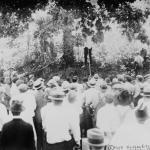Lynching as Racial Terrorism
https://portside.org/2015-02-11/lynching-racial-terrorism

Portside Date:
Author: The Editorial Board
Date of source:
The New York Times

It is important to remember that the hangings, burnings and dismemberments of black American men, women and children that were relatively common in this country between the Civil War and World War II were often public events. They were sometimes advertised in newspapers and drew hundreds and even thousands of white spectators, including elected officials and leading citizens who were so swept up in the carnivals of death that they posed with their children for keepsake photographs within arm’s length of mutilated black corpses.
These episodes of horrific, communitywide violence have been erased from civic memory in lynching-belt states like Louisiana, Georgia, Alabama, Florida and Mississippi. But that will change if Bryan Stevenson, a civil rights attorney, succeeds in his mission to build markers and memorials at lynching sites throughout the South as a way of forcing communities and the country to confront an era of racial terror directly and recognize the role that it played in shaping the current racial landscape.
Mr. Stevenson’s organization, the Equal Justice Initiative, took a step in that direction on Tuesday when it released a report that chronicles nearly 4,000 lynchings of black people in 12 Southern states from 1877 to 1950. The report focuses on what it describes as “racial terror lynchings,” which were used to enforce Jim Crow laws and racial segregation. Victims in these cases were often murdered without being accused of actual crimes but for minor social transgressions that included talking back to whites or insisting on fairness and basic rights.
The report is the result of five years of hard work. Researchers reviewed local newspapers, historical archives and court records; interviewed local historians, survivors and victims’ descendants; and scrutinized contemporaneously published articles in African-American newspapers, which took a closer interest in these matters than the white press. In the end, researchers found at least 700 more lynchings in the 12 states than were previously reported, suggesting that “racial terror lynching” was far more common than was generally believed.
The report argues compellingly that the threat of death by lynching was far more influential in shaping present-day racial reality than contemporary Americans typically understand. It argues that The Great Migration from the South, in which millions of African-Americans moved North and West, was partly a forced migration in which black people fled the threat of murder at the hands of white mobs.
It sees lynching as the precursor of modern-day racial bias in the criminal justice system. The researchers argue, for example, that lynching declined as a mechanism of social control as the Southern states shifted to a capital punishment strategy, in which blacks began more frequently to be executed after expedited trials. The legacy of lynching was apparent in that public executions were still being used to mollify mobs in the 1930s even after such executions were legally banned.
Despite playing a powerful role in the shaping of Southern society, the lynching era has practically disappeared from public discourse. As the report notes: “Most Southern terror lynching victims were killed on sites that remain unmarked and unrecognized. The Southern landscape is cluttered with plaques, statues and monuments that record, celebrate and lionize generations of American defenders of white supremacy, including public officials and private citizens who perpetrated violent crimes against black citizens during the era of racial terror.”
Mr. Stevenson’s group makes the persuasive argument that this history needs to be properly commemorated and more widely discussed before the United States can fully understand the causes and origins of the racial injustice that hobbles the country to this day.
